 To enhance service speed and avoid tariff delays, we've opened a US warehouse. All US orders ship directly from our US facility.
To enhance service speed and avoid tariff delays, we've opened a US warehouse. All US orders ship directly from our US facility.
| Cat. No. | Product Name | Field of Application | Chemical Structure |
|---|---|---|---|
| DC70809 | STAT3 inhibitor N4 Featured |
STAT3 inhibitor N4 is a small molecule capable of inhibiting the STAT3 SH2 domain with IC50 of 0.57 uM, SPR KD of 1.04 uM, inhibits STAT3 dimerization and transcription in vitro and suppresses pancreatic cancer in vivo.N4 suppresses STAT3 activation in pancreatic cancer cells, suppresses pancreatic cancer cell growth, migration, and induces apoptosis.N4 (20 mg/kg, i.p.) suppresses pancreatic cancer growth, exhibits potent anti-metastatic activity in a pancreatic cancer liver metastasis mouse model, and prolongs survival of tumor-bearing mice.
More description
|
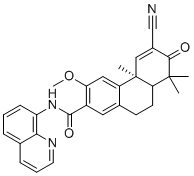
|
| DC22504 | Leuprorelin Featured |
Leuprorelin (Leuprolide) is a GnRH analog and agonist of GnRH receptor, interrupts the normal pulsatile stimulation and desensitizing of the GnRH receptors..
More description
|
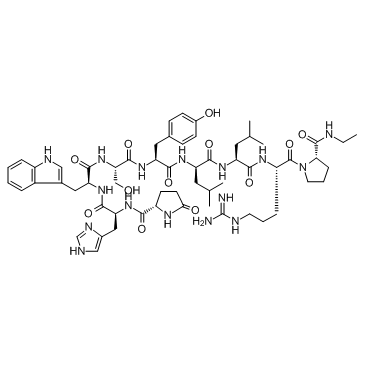
|
| DC67602 | ILB-3132(E12LA6B603) Featured |
E12LA6B603(ILB3132,ILB-3132) is a novel ionizable amino lipid disclosed in patent WO2024198497A1, developed by MagicRNA, representing a highly efficient component for lipid nanoparticle (LNP) delivery systems.When formulated into LNPs, E12LA6B603 LNP achieves a remarkable 98.26% encapsulation efficiency for mRNA. It mediates superior in vitro transfection in dendritic cells (1.8E+05 intensity) and demonstrates best-in-class in vivo protein expression after intramuscular injection (2.2E+09 intensity). Most notably, in a B16-OVA melanoma model, therapeutic OVA-mRNA vaccines delivered by E12LA6B603 LNPs induced 100% complete tumor regression, highlighting its superior efficacy over benchmarks like DLin-MC3 and SM-102. Its biodegradable ester linkages and balanced structure make it a promising, potent candidate for next-generation mRNA vaccines and therapeutics.
More description
|

|
| DC11569 | E3 Ligand-Linker Conjugate 4 Featured |
An E3 ligase ligand-linker conjugate for PROTAC...
More description
|
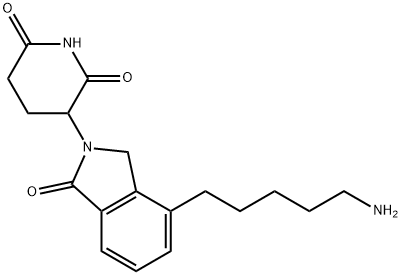
|
| DCC4183 | Pladienolide B Featured |
Pladienolide B is a potent cancer cell growth inhibitor that targets the SF3B1 subunit of the spliceosome. Pladienolide B exerts antitumor activities mediated through the inhibition of pre-mRNA splicing. Pladienolide B induces apoptosis.
More description
|
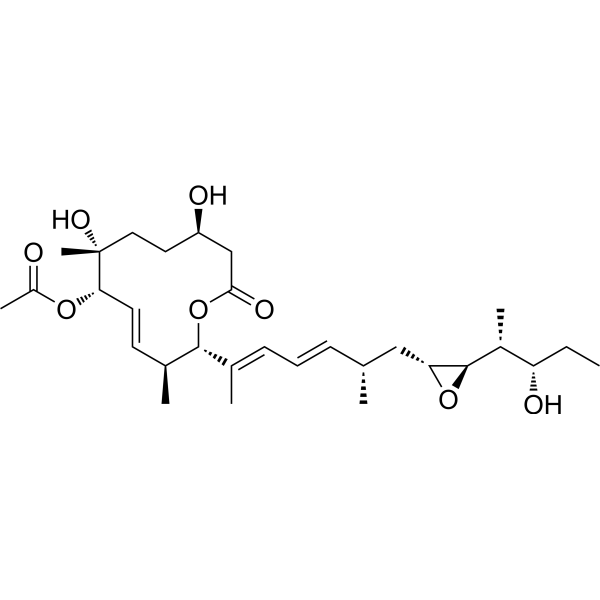
|
| DC47162 | 10-Nitrooleic acid Featured |
10-Nitrooleic acid (CXA-10), a nitro fatty acid, has potential effects in disease states in which oxidative stress, inflammation, fibrosis, and/or direct tissue toxicity play significant roles.
More description
|
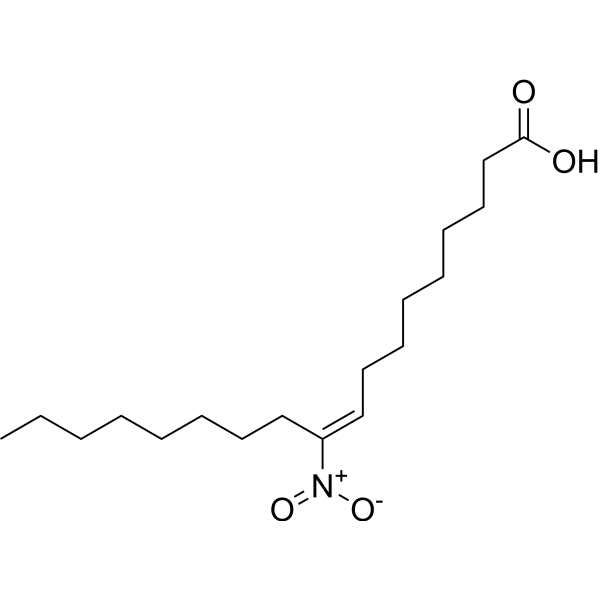
|
| DC73346 | TGP-29b-066 Featured |
TGP-29b-066 (Targapremir-29b-066) is a specfic small-molecule miR-29b inhibitor that targets miR29b hairpin precursor (pre-miR-29b), selectivity and effectively decreases miR-29b expression levels in C2C12 myoblast, attenuates muscle atrophy in vitro and
More description
|

|
| DC7575 | 10058-F4 Featured |
10058-F4 is a c-Myc inhibitor that specificallly inhibits the c-Myc-Max interaction and prevents transactivation of c-Myc target gene expression.
More description
|
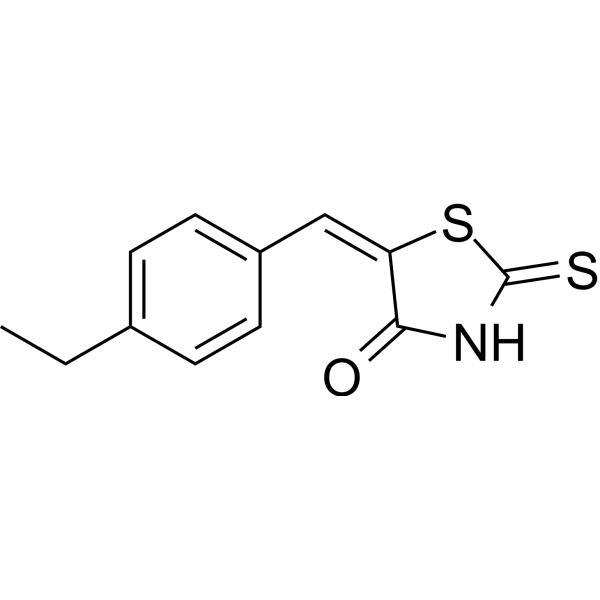
|
| DC9676 | AT7519 Featured |
AT7519 is a multi-CDK inhibitor for CDK1, 2, 4, 6 and 9 with IC50 of 10-210 nM; less potent to CDK3 and little active to CDK7.
More description
|
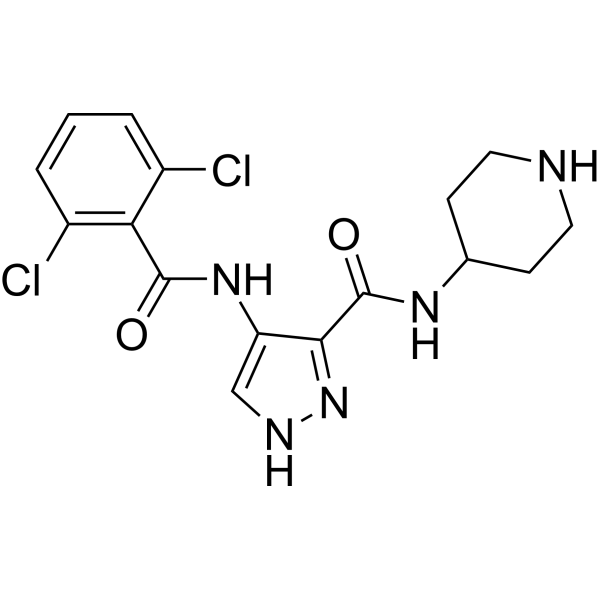
|
| DC8075 | Purvalanol A(NG 60) Featured |
Purvalanol A is a potent, cell-permeable cyclin-dependent protein kinase (cdk) inhibitor.
More description
|
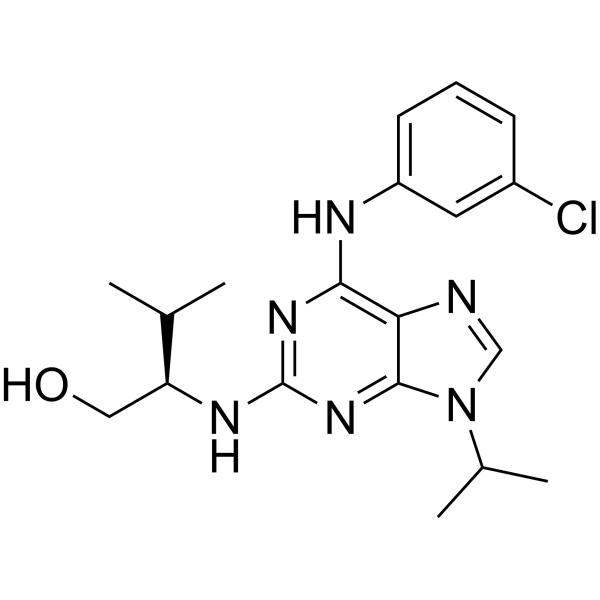
|
| DC32991 | Myoseverin Featured |
Myoseverin is an inducer of the reversible fission of multinucleated myotubes into mononucleated fragments, affecting the expression of a variety of growth factor, immunomodulatory, extracellular matrix-remodeling, and stress response genes, consistent with the activation of pathways involved in wound healing and tissue regeneration.
More description
|
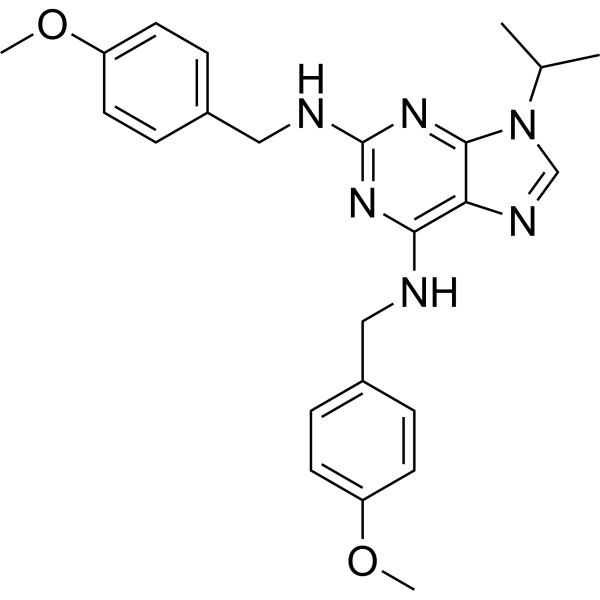
|
| DC9306 | CVT-313(NG-26) Featured |
CVT-313(NG-26) is a potent, selective, reversible, and ATP-competitive inhibitor of CDK2 (IC50 = 0.5 uM for Cdk2/A and Cdk2/E; 4.2 uM for Cdk1/B; 215 uM for Cdk4/D1).
More description
|
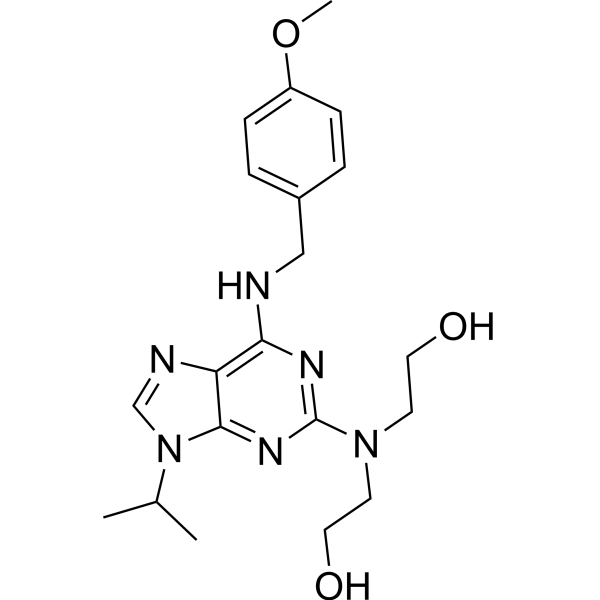
|
| DC67614 | (diamine)bis(3-carboxypropanoato)(dichlorido)platinum(IV) Featured |
bis(3-carboxypropanoato)(dichlorido)platinum(IV).png)
|
|
| DC2099 | cis-Diaminedichloroplatinum Featured |
Cisplatin is an inorganic platinum agent (cis-diamminedichloroplatinum) with antineoplastic activity.
More description
|
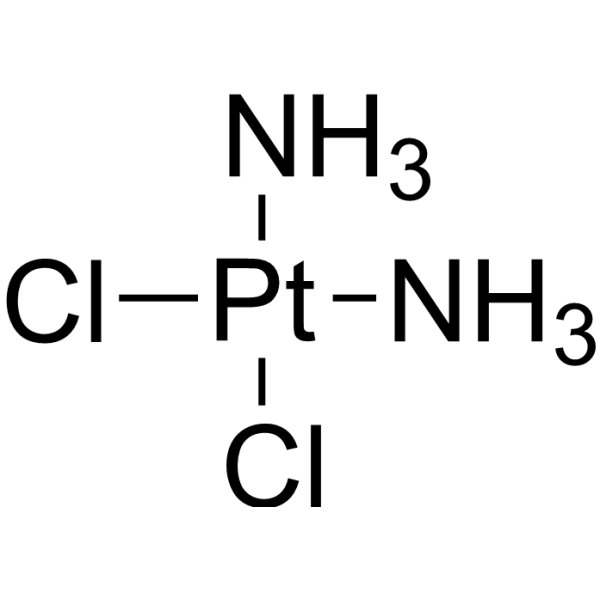
|
| DC67613 | [Pt(DACH)(OH)2(ox)] Featured |
[Pt(DACH)(OH)2(ox)] (Dihydroxy Oxaliplatin-Pt(IV)) is a Oxaliplatin (HY-17371)-based Pt(IV) scaffold. [Pt(DACH)(OH)2(ox)] reacts with N-hydroxysuccinimide (NHS) ester of Pyropheophorbide-a (HY-128973) to yield phorbiplatin. Phorbiplatin is a highly potent Pt(IV) antitumor prodrug.
More description
|
(OH)2(ox)].gif)
|
| DC67612 | Magnesium acetyl taurate Featured |
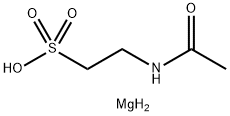
|
|
| DC67611 | (S)-5-Methoxy-N-propyl-1,2,3,4-tetrahydronaphthalen-2-amine hydrochloride Featured |
(S)-5-Methoxy-N-propyl-1,2,3,4-tetrahydronaphthalen-2-amine hydrochloride is a drug intermediate for synthesis of various active compounds.
More description
|
-5-Methoxy-N-propyl-1,2,3,4-tetrahydronaphthalen-2-amine hydrochloride.gif)
|
| DC67610 | (s)-2-Amino-5-methoxytetralin hydrochloride Featured |
(s)-2-Amino-5-methoxytetralin hydrochloride is a drug intermediate for synthesis of various active compounds.
More description
|
-2-Amino-5-methoxytetralin hydrochloride.gif)
|
| DC5015 | Rotigotine Hydrochloride Featured |
Rotigotine is dopamine D2 and D3 receptor agonist. Ki values are 13 and 0.71 nM for D2 and D3 respectively. Rotigotine also has significant affinity for 5-HT1A and adrenergic α2B receptors. Rotigotine exhibits antiparkinsonian acitivity.
More description
|

|
| DC67609 | Cbz-TRIS tri-acid Featured |
Cbz-TRIS tri-acid is a small molecule compound containing several functional groups, including a carbamate group, a tris group, and three carboxylic acid groups.
More description
|
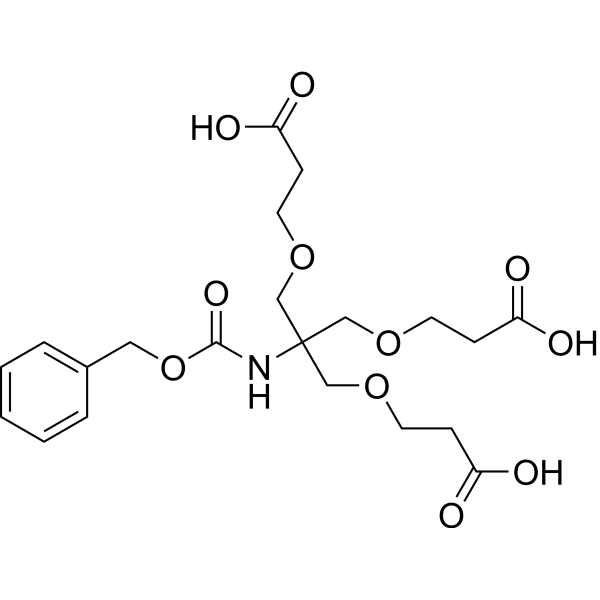
|
| DC67608 | 1-Pyrrolidinedodecanoic acid, 2-[[bis(4-methoxyphenyl)phenylmethoxy]methyl]-4-hydroxy-λ-oxo-, (2S,4R)-, compd. with N,N-diethylethanamine (1:1) Featured |
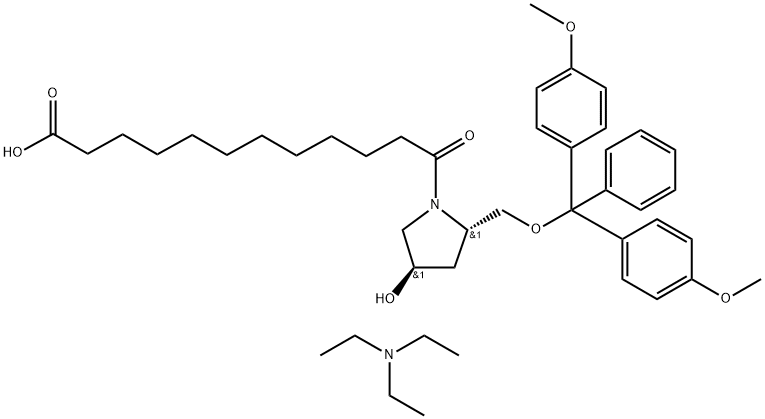
|
|
| DC30002 | PF-06835919 Featured |
PF-06835919, also known as MDK1846, is a potent ketohexokinase (KHK) inhibitor. PF-06835919 is reported in patent US 20170183328 A1, example 4. Increased fructose consumption and its subsequent metabolism have been implicated in hepatic steatosis, dyslipidemia, obesity, and insulin resistance in humans. Since ketohexokinase (KHK) is the principal enzyme responsible for fructose metabolism, identification of a selective KHK inhibitor may help to further elucidate the effect of KHK inhibition on these metabolic disorders.
More description
|
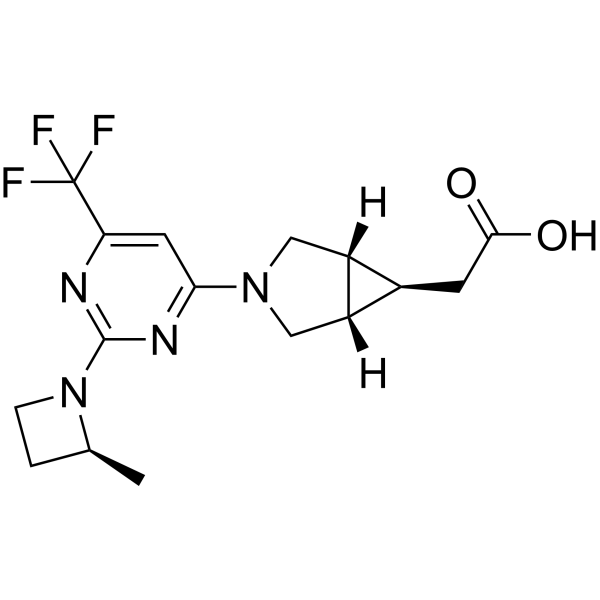
|
| DC31030 | Vonafexor(PLX007,EYP-001) Featured |
Vonafexor (EYP001) is a selective FXR agonist with anti-HBV effects.
More description
|
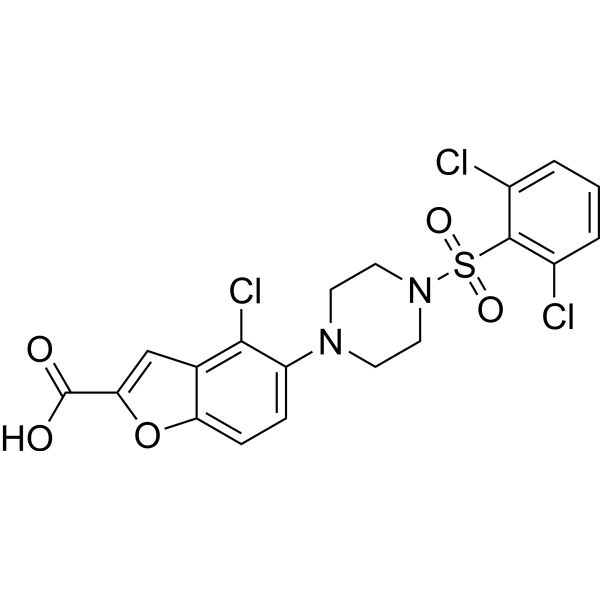
|
| DC21457 | Pax2 inhibitor EG1 Featured |
Pax2 inhibitor EG1 (EG1) is a potent, small molecule inhibitor of Pax2 mediated transcription activation, effectively blocks Pax2 activity and DNA binding with Kd of 1.35-1.5 uM; inhibits Pax2 mediated expression with IC50 of 10 uM, and inhibits proliferation of Pax2 positive renal and ovarian cancer cell lines but has little effect on Pax2 negative cancer cells; inhibits embryonic kidney development.
More description
|
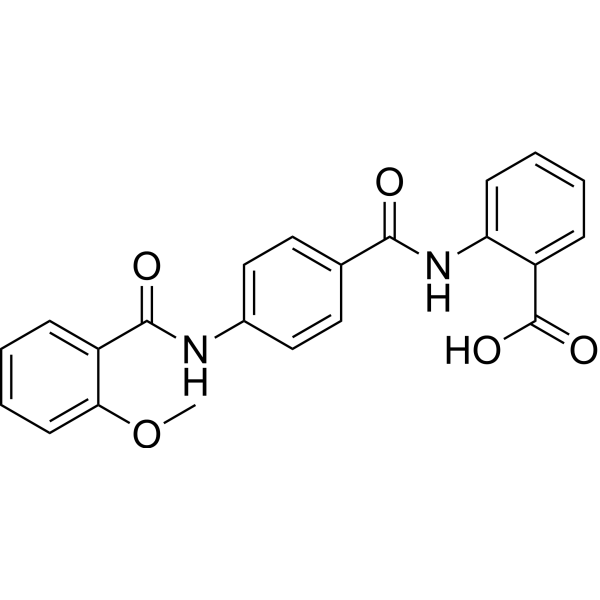
|
| DC67607 | 4-bromo-2-(1H-tetrazol-5-yl)aniline Featured |
aniline.png)
|
|
| DC67606 | Dac590 Featured |
Dac590 is an orally active FTO inhibitor. Dac590 has a robust antiproliferative effect on AML cells, and induces apoptosis and cell cycle G1 arrest by inhibiting oncogenic FTO signaling. Dac590 significantly inhibits tumor growth and prolongs survival with no observed toxicity in acute myeloid leukemia (AML) xenograft mcie model, and shows a synergistic effect combined with Decitabine (HY-A0004).
More description
|
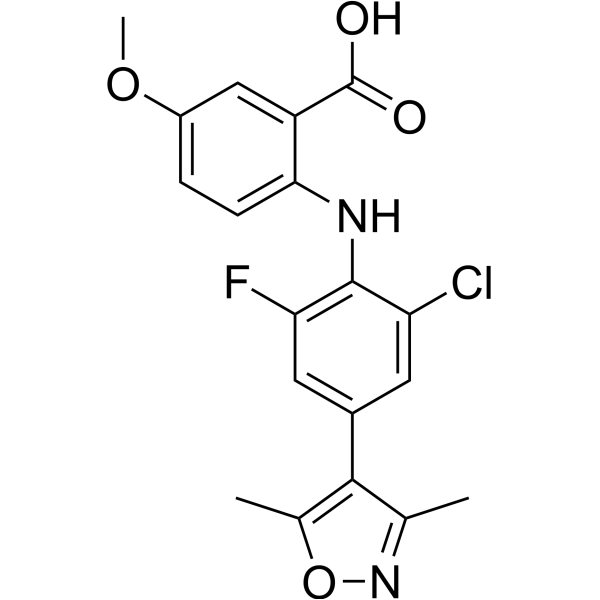
|
| DC10061 | PI4KA inhibitor-A1 Featured |
GSK-A1 is a potent inhibitor of PI4KA. In vitro using HEK-AT1 cells, GSK-A1 had an IC50 of about 3 nM.
More description
|
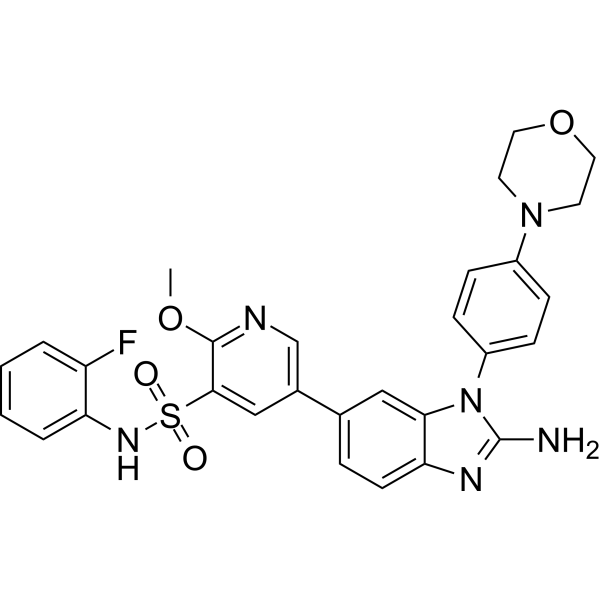
|
| DC26118 | AKI-7169(Aurora Kinase Inhibitor III) Featured |
Aurora kinase inhibitor III is a potent inhibitor of Aurora A kinase (IC50 = 42 nM).
More description
|
.gif)
|
| DC44159 | Enpatoran Featured |
Enpatoran (M5049) is an orally active and dual TLR7/8 inhibitor with IC50s of 11.1 nM and 24.1 nM in HEK293 cells, respectively. Enpatoran can block both innate and adaptive autoimmunity. Enpatoran is inactive against TLR3, TLR4 and TLR9. Enpatoran (M5049) can block molecule synthetic ligands and natural endogenous RNA ligands. Enpatoran (M5049) inhibits cytokine release, causing great potency in pharmacokinetic/pharmacodynamic properties.
More description
|
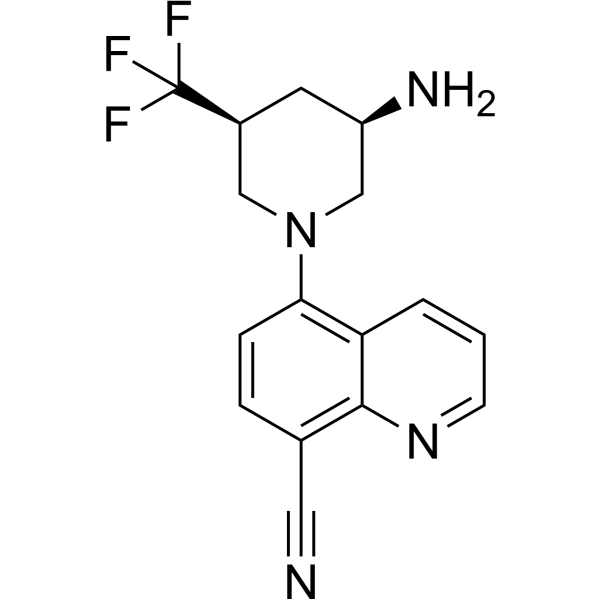
|
| DC67605 | PyCB lipid Featured |
The PyCB (Pyridine Carboxybetaine) lipid is a rationally designed zwitterionic ionizable lipid that serves as a core functional component in the novel three-component (ThrCo) lipid nanoparticle (LNP) platform. It is synthesized by covalently attaching a zwitterionic PyCB structure to the hydroxyl group of the clinically available ionizable lipid ALC-0315.Its key feature is its pH-responsive behavior. At physiological pH (~7.4), the PyCB headgroup exhibits zwitterionic properties, forming charge-assisted hydrogen bonds with water molecules (PyCB-H₂O complexes). This confers high hydrophilicity to the LNP surface, enhancing stability in aqueous environments and reducing nonspecific protein adsorption in the bloodstream. This zwitterionic surface effectively mimics and replaces PEGylated lipids, thereby avoiding PEG immunogenicity and the associated Accelerated Blood Clearance (ABC) effect upon repeated administrations.Crucially, in the acidic environment of endosomes (pH ~6.5), the PyCB group undergoes strong protonation, rapidly transforming into a cationic state (PyCB-H₃O⁺ complexes). This promotes efficient fusion with and disruption of the endosomal membrane, facilitating the escape and cytoplasmic release of encapsulated mRNA.By replacing both cholesterol and PEGylated lipids in traditional LNPs, PyCB lipid enables the redirection of LNP biodistribution from the liver to the spleen, achieving superior spleen-specific mRNA translation and enhancing antigen presentation for potent immune activation.
More description
|

|